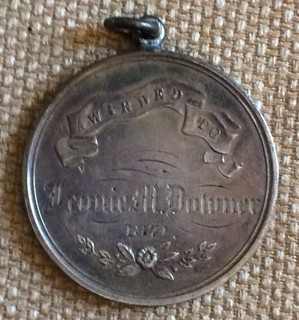
PREV ARTICLE
NEXT ARTICLE
FULL ISSUE
PREV FULL ISSUE
V25 2022 INDEX E-SYLUM ARCHIVE MORE ON WOMEN AND THE U.S. MINTJerome Nashorn submitted this piece with more background on the early women of the U.S. Mint. Thank you! -Editor More on women and the Mint in the late 19th Century It was interesting to read about female U.S. Mint adjusters having to resign when they got married. However, this is not surprising given that the so-called marriage bar for women was common, in both public and private employment, until several decades into the 20th century.
The dismissals were explained as an economy move but may have also been motivated by the new administration's desire to purge employees who'd been appointed during prior Republican administrations. After leaving the Mint, Downer, who never married, remained in San Francisco and worked as a stenographer. She died there in 1916. According to her obituary, she came from a "pioneer San Francisco family" and had been a "leader" in the charitable activities of Grace Episcopal Cathedral on Nob Hill (see Daily Call, September 4, 1916, also available on the California Digital Newspaper Collection website). The lot of the early Mint adjusters, who were overwhelmingly women in the 19th century, was clearly not easy. In addition to being subject to the marriage bar and the vicissitudes of the spoils system, they worked under unpleasant conditions, primarily because the adjusting rooms purposely were not provided with adequate ventilation in order to ensure the accuracy of the scales and probably to prevent any grains of precious metal from escaping. This state of affairs was summed up in a letter sent to Abraham Lincoln in 1861 by a Philadelphia physician, which Len Augsburger posted to the June 30, 2019, issue of The E-Sylum. The doctor's letter referred to the adjusters as "respectable ladies of reduced means." This description certainly fits Jennie Downer. Her father, Abner J. Downer, is described in directories issued in the 1860s as a merchant or stock broker, with an office in the San Francisco Merchant's Exchange. However, in the 1871 Directory, there is a an entry for an A.J. Downer, who is listed as a clerk. Presumably after his death in 1872 or perhaps soon before, his wife and Jennie, his only child, found themselves in reduced circumstances forcing Jennie to seek employment when she reached adulthood. Downer's job at the Mint paid well given the other options that would have been available to her. Jennie and her fellow adjusters, all women, were paid $2.75 per day. According to a Treasury Department Bureau of Statistics Report to Congress on Internal Commerce, submitted at the end of 1890 (available on Google Books, see p. 384), female saleswomen in California received on average only $5 per week while women in many occupations in manufacturing received considerably less (female employees at a San Francisco silk factory were paid between $3 and $5.25 per week, for example, see p. 395). Of course, just as in the private sector, the adjusters were paid less than almost all male San Francisco Mint employees who also did jobs that required minimal skills or training. For example, in 1883, janitors received $3 per day as did the messengers while workmen were paid $4 a day; only some of the watchmen were paid less than the adjusters, with most getting $2.50 a day. Men filled all of the relatively few clerical positions the Mint had to offer and were paid about $4 a day. And all the managerial jobs as well as those of a technical nature were filled by men. All the women employed at the Mint in 1883 were listed as adjusters except for the adjusting room janitor, a woman who was paid $2.25 a day, 75 cents less than the other janitors, who were all men. Since the coiners (also women) are not broken out as a separate occupation, I suspect they were lumped in with the adjusters. This data is from the Official Register of the United States for 1883 (available online at the Hathi Trust, see pp. 159ff). The same pattern can be seen in the other Mints: women were pretty much limited to being adjusters and coiners and earned less than nearly all the male employees, including those in clerical positions as well as men holding menial jobs. Of course, this was the state of affairs in other workplaces, both public and private, during that era. Today, the Mint regards the 19th century adjusters as "trailblazers" for women in the workplace. A puff piece on the subject is currently on the Mint's official website. It paints a fairly favorable picture of the adjusters' experience, though it does acknowledge the poor ventilation.
References:
To read the earlier E-Sylum articles, see:
Wayne Homren, Editor The Numismatic Bibliomania Society is a non-profit organization promoting numismatic literature. See our web site at coinbooks.org. To submit items for publication in The E-Sylum, write to the Editor at this address: whomren@gmail.com To subscribe go to: https://my.binhost.com/lists/listinfo/esylum All Rights Reserved. NBS Home Page Contact the NBS webmaster 
|


